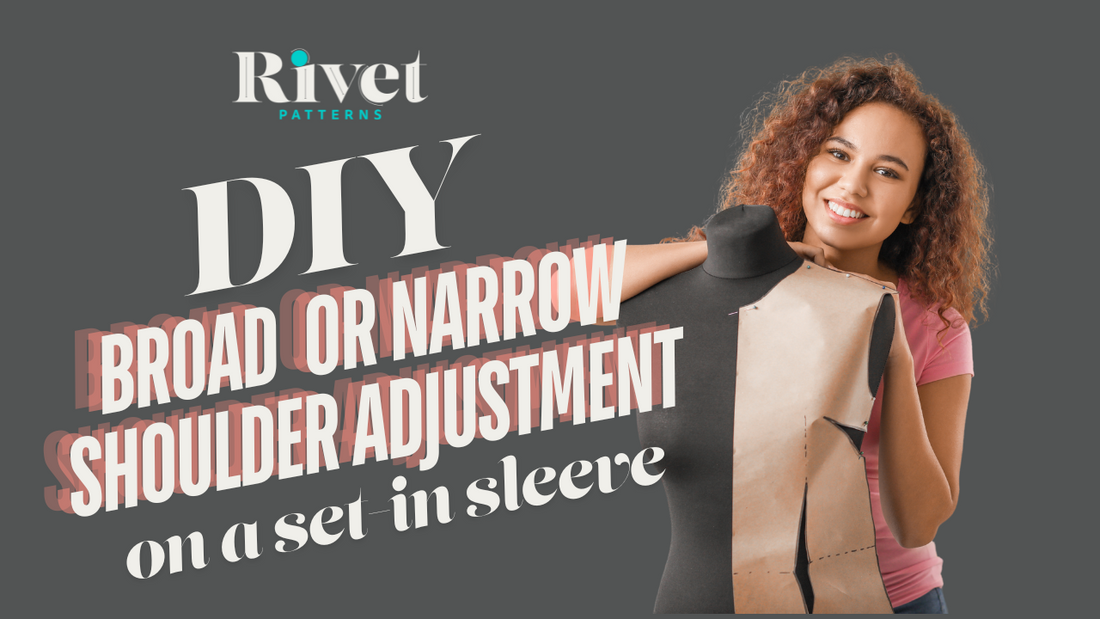In this post, we are going to talk about Shoulders! Specifically, how to do a Broad or Narrow Shoulder Adjustment for a Set In Sleeve, but I'd like to quickly touch on shoulders in all of their manifestations.
Shoulders can be broad or narrow, meaning the actual LENGTH of the pattern's shoulder line needs to be longer or shorter to accommodate. Shoulders can be square or sloped, meaning that the ANGLE of the shoulder is more horizontal or vertical than that of the pattern. Shoulders can also be forward or backward, meaning that the shoulder line of the pattern needs to shifted forward or backward to match the line of the wearer.
For a visual explanation of these differences, check out this video: It is entirely possible to need more than one, or all three, shoulder adjustments.
If you would like to follow along with me on video, you can find us over on YouTube.
A broad or narrow shoulder adjustment is focusing on altering the overall length of the shoulder seam. When you raise your arm in the air, the place your shoulder creases is where the sleeve cap should sit. If your shoulder is longer than the pattern is drafted for, you'll find that the sleeve cap is being pulled up towards the neck. If your shoulder is shorter than the pattern is drafted for, you'll find the sleeve cap is hanging down on the shoulder (NOT to be confused with a drop shoulder which is an intentional pattern design).
Start by drawing in your seam allowances through the shoulder line and armscye. You are then going to make two marks. The first mark, make at approximately the halfway point of the shoulder line. The second mark, make at approximately the upper third of the armscye.


Next, you are going to draw two lines. The first line will be between the two marks you made in the previous step. The second line will be from the end of the shoulder line to the new line you just drew. This line will be approximately a 45 degree angle to the shoulder line.


Mark the three pivot points (green dots). Then, you will clip through the seam allowance to the pivot points at the armscye point, and the end of the shoulder line point. Do nothing with the shoulder line point (yet).


We are going to make two cuts. The first cut is from the shoulder line pivot point to the armscye pivot point. When you get to the armscye pivot point, cut to, but not through. The second cut will be from your first cutline, to the corner pivot point. Again, cut to, but not through. This will give you two hinges.


Alright! Now we're ready to start our adjustment!
BROAD SHOULDER
You'll need to determine how much you need to add. Typically, you'll figure this from your muslin, but it may take a few tries to get it right. Slide the hinge at the shoulder point outward, adding the length into the shoulder line. This will move the armscye hinge as well, changing the shape slightly, but not the length.

Once you have added your desired amount, slide a piece of paper behind your adjusted pattern, and redraw. You'll notice that the shoulder line and armscye will need to be redrawn. Using a straight ruler, draw a straight line from the shoulder point to the neck point. Gently smooth out the armscye, truing the corner.


Repeat all of these steps on the back bodice piece as well. That's it! You're all done!
NARROW SHOULDER:
You'll need to determine how much you need to subtract. Typically, you'll figure this from your muslin, but it may take a few tries to get it right. Slide the hinge at the shoulder point inward, subtracting the length out of the shoulder line. This will move the armscye hinge as well, changing the shape slightly, but not the length.

Once you have subtracted your desired amount, slide a piece of paper behind your adjusted pattern, and redraw. You'll notice that the shoulder line and armscye will need to be redrawn. Using a straight ruler, draw a straight line from the shoulder point to the neck point. Gently smooth out the armscye, truing the corner.


Repeat all of these steps on the back bodice piece as well. That's it! You're all done!
Happy Making!
Rachelle

